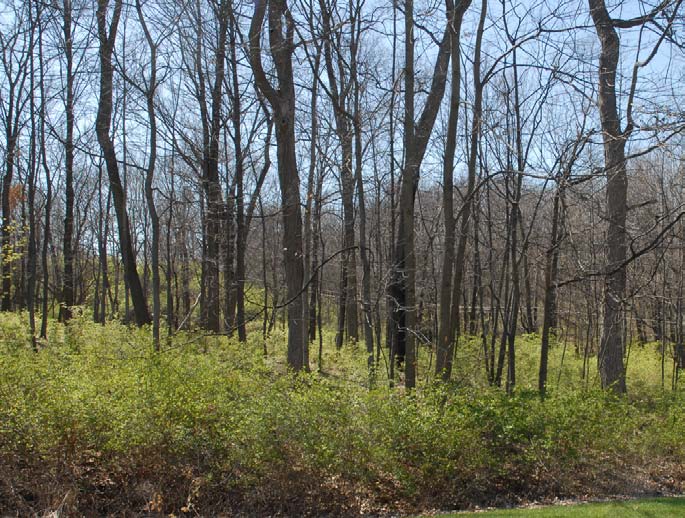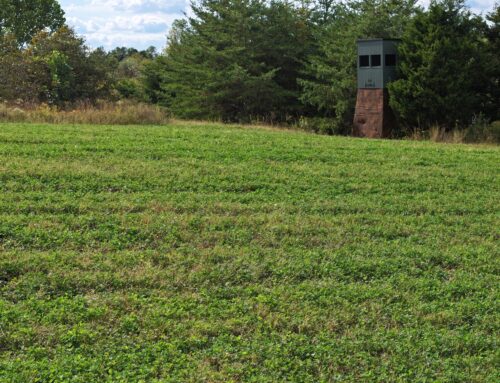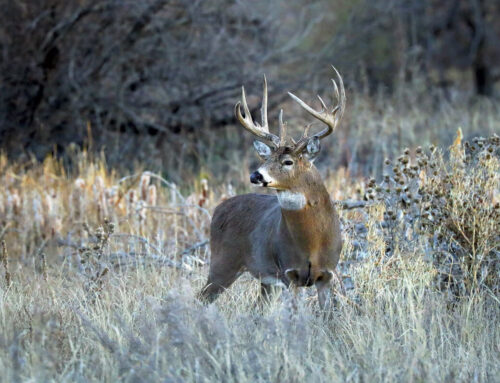You Can Easily Spot Invasive Plant Species Now
The spring season is one of the easiest times of the year to spot invasive plant species.
As the season transitions into spring, take a look at wooded areas and along roadsides, but before the trees have budded out. Do you see any green vines? How about green shrubs? If your answer is “yes”, you’re most likely looking at an invasive plant.

How do we know this?
Invasive, non-native/exotic species, have a longer growing season and shorter dormancy period compared our native species. Our native species adapted to the harsh winter conditions of our climate. Over time, those plant individuals with shorter dormancy periods were naturally selected against and were less likely to survive harsh winters. Conversely, those plant individuals with longer dormancy periods survived the winter conditions to pass on these traits. Over time, our native species evolved to be better adapted to survive the harsh winter conditions. However, since invasive plant species are not native to our climate, they never had to go through this period of cold weather adaptation, as majority of our invasive plant species are native to warmer climates. These plants have longer growing seasons and a shorter dormancy period when compared to our native species. Having a shorter dormancy period when compared to our native species means these invasive plants are the first species to begin budding/leafing out once the warmer temperatures of spring appear, resulting in the first (new) shades of green to be seen across the landscape in spring, as well as the last shades of green to be seen in the fall.
Given this information, if you are seeing green across the landscape this time of year, you’re most likely look at an invasive species of plant. The only exception to this would be your occasional coniferous (evergreen) tree or spice bush. Although spice bush also buds out early, it’s actually a native species. However, spice bush is known to have invasive tendencies and can take over areas as non-native species can.

What this means and why you should care.
One of the major ecological problems with invasive plant species is they out-compete our native species for the same vital nutrients as well as sunlight and water. Because invasive species have a longer growing season, they are also able to better compete for available growing space as their growing season begins several weeks ahead of our native plant species. Invasive plants reproduce and establish faster than our native species. Once invasive plants have taken over an area, sunlight has a harder time reaching the ground, thus drastically hindering the forest’s ability to naturally regenerate and produce new, native plants. A forest or property which has become invaded by invasive plant species will be less productive. The native species will struggle to compete and may eventually begin dying out, giving way for the invasive species to move into this available growing space. This also has a negative effect on wildlife as they heavily depend on our native species for sources of food and shelter.

How are invasive plant species managed/treated?
Invasive species management involves either mechanical removal, chemical treatment, or a combination of the two strategies, to treat the invasive plants. The specific prescription for treatment is determined by the target species and the extent of the invasion. Herbicides are used in the chemical treatment of invasive plant species through the use of various sprayers such as backpack sprayers or sprayers on the backs of ATV’s/UTV’s, to target invasive species while avoiding the desirable, native species. The specific method and chemical utilized for herbicide application depends on the target species and layout of the property. Herbaceous (non-woody/vascular) invasive species are generally treated by foliar (leaf) spraying, whereas woody invasive species (trees and shrubs) are generally treated by either foliar spraying or through mechanical removal. Invasive plants are usually mechanically removed by cutting at the base of the plant, by chainsaws or brush saws. The stumps of the removed plant should then be sprayed with herbicide to prevent the plant from re-sprouting, by killing its root structure. This is known as the cut-stump treatment method. If the plant invasion is severe enough, a mulching head attachment on a heavy piece of equipment, such as a skid steer or excavator, can be utilized to completely clear an area. This equipment can also be utilized to create access trails so the invasive plants can be removed more efficiently by the use of herbicide sprayers.

Realizing you have an invasive species problem on your property and would like help addressing the problem?
Give us a call to set up a consultation and to discuss treatment options. (260) 668-9977

Additional Information:






